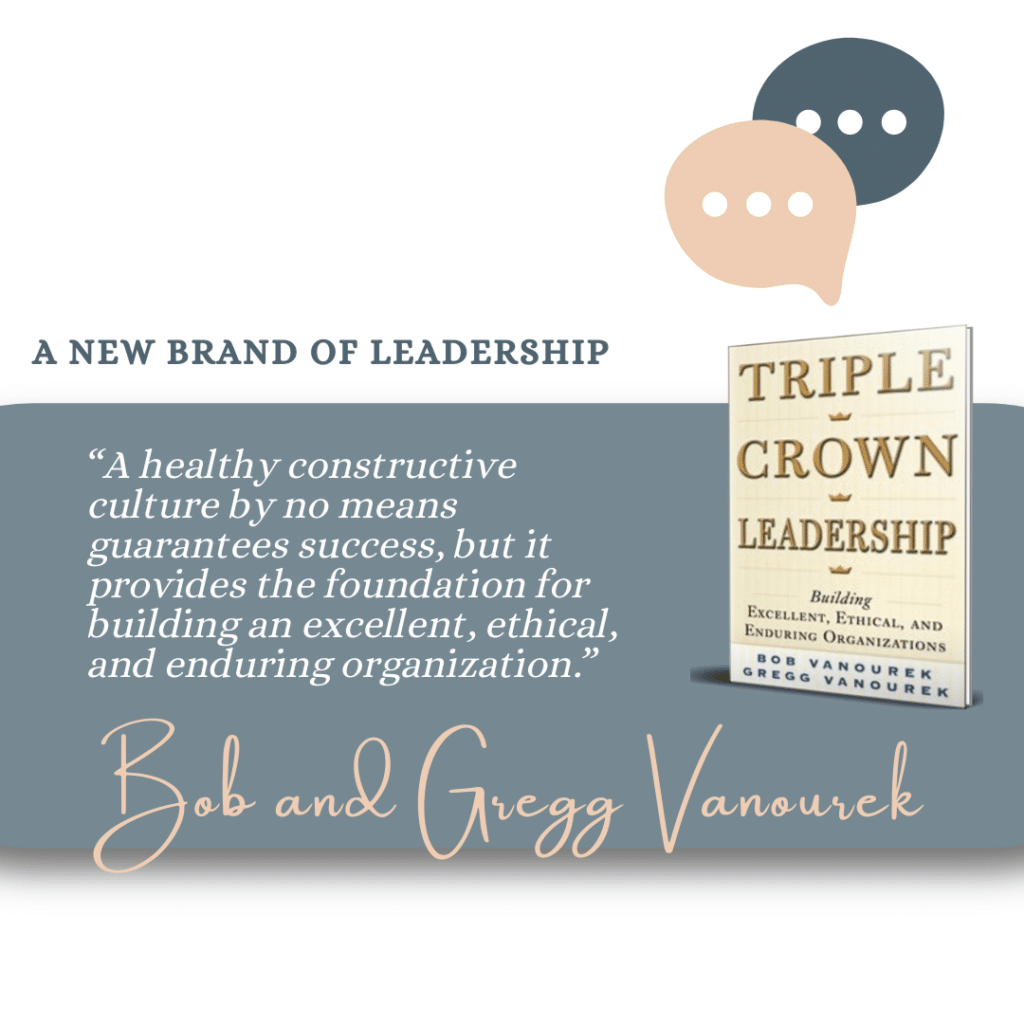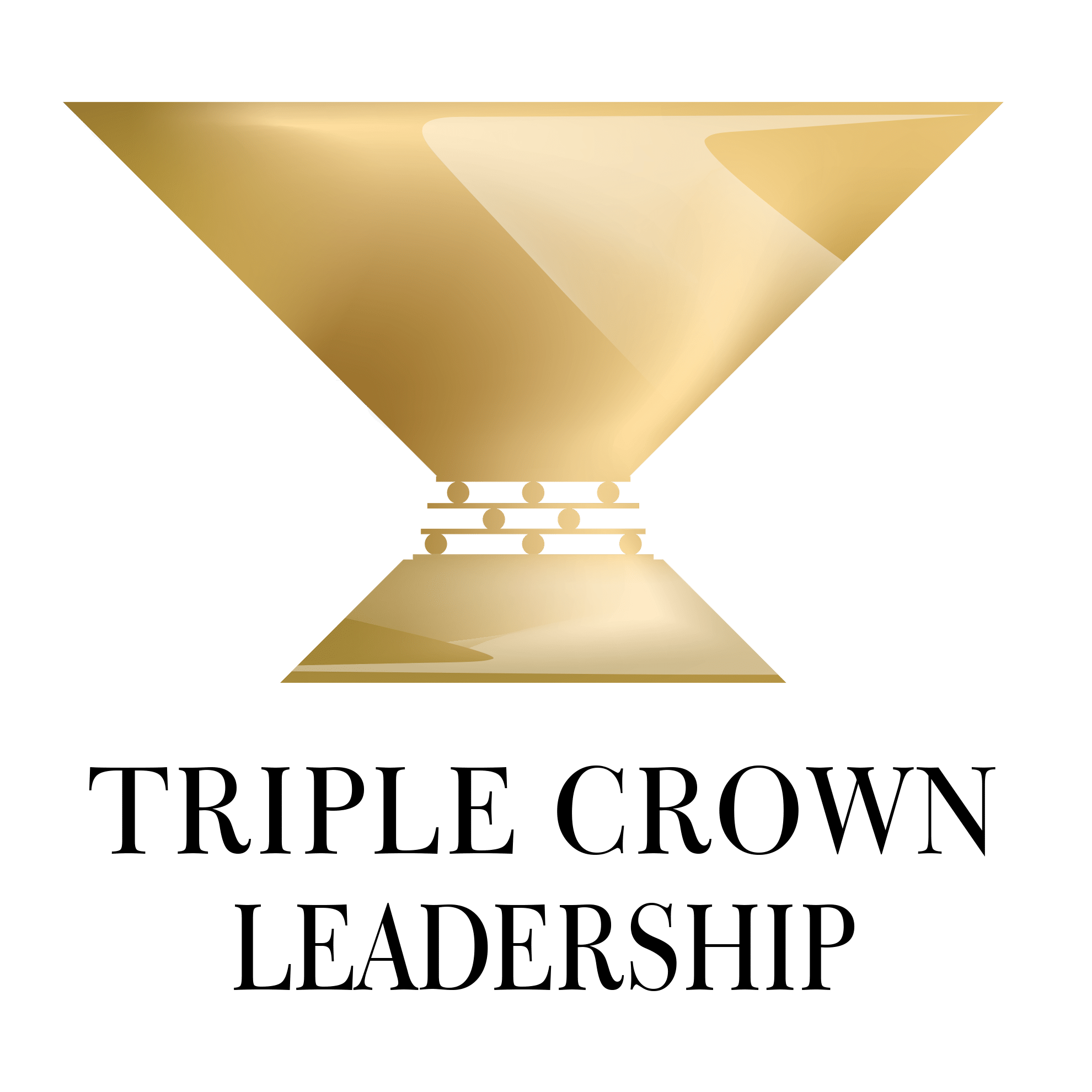Most leaders understand that organizational culture is important. But many struggle with how to change and improve their culture. For too many leaders, culture is too ethereal, too hard to measure, too intangible. So, they muddle along with speeches, slogans, or projects, but their organizational culture refuses to budge. That’s unfortunate because your ideal culture can be created.
Culture is the legacy of leadership.
In our book, Triple Crown Leadership: Building Excellent, Ethical, and Enduring Organizations, we defined organizational culture simply as “how we do things here”—how people behave. We said, “Culture forms over time and drives what happens when the authorities are not present. It sets the tone for the organization and the norms for what is acceptable to the group. Culture is a powerful force in determining how an organization operates.”
Culture Is the Game
Lou Gerstner, after his spectacular turnaround of IBM, wrote,
“…culture isn’t just one aspect of the game—it is the game.”
His successor, Sam Palmisano, subsequently said,
“Culture is perhaps the hardest area to influence but fundamental to success.”
Culture helps people determine what to do and gives the organization a sense of identity and community. Indeed, famed management author Peter Drucker once said,
“Culture eats strategy for breakfast.”
How to Create Your Ideal Culture
So, how can you go about creating your ideal culture? We’ll share a 12-step approach that has worked for us and will likely work for you. The critical first step is to realize that you can and should act to create the ideal culture you want and that your organization hungers for. Culture is not a mystery; it’s within your leadership skills to create.
The next three steps in creating your ideal culture are to undertake the collaborative process of defining the “colors” of your organization: the shared purpose, values, and vision. Your culture work will flow beautifully from these critical and aspirational statements of why your organization exists (purpose), how you will collectively behave (values), and what success looks like in the future when it is achieved (vision).
Unlike the typical, vapid mission statement of most organizations, a purpose statement is a compelling and inspirational statement about why your organization exists, its reason for being. It is short enough to fit on a T-shirt and memorable enough to be recalled by everyone in the organization.
The shared values are the core beliefs for how employees pledge to behave with each other and your various stakeholders. Ideally, shared values are five to seven standalone words that can form a memorable acronym and which may have some explanatory phrases that embellish the core words.
The vision is where the organization will ideally be in the medium-term future. It’s a believable, inspiring, and vivid word picture of several sentences, or a few paragraphs, of what the organization will look, sound, and feel like when your organizational dreams are being achieved.
The organization’s shared purpose, values, and vision should be collaboratively elicited to gain buy-in and commitment, not pushed down from the top leader.
If you’re satisfied with your organization’s purpose, values, and vision, then you can skip these first three steps. If you’re not satisfied, then begin here with your why, how, and what. Your culture work will flow from them.

Leadership Derailers Assessment
Take this assessment to identify what’s inhibiting your leadership effectiveness. It will help you develop self-awareness and identify ways to improve your leadership.
Culture-Building
Once the organization’s “colors” have been defined, it’s time to reassemble your senior management team, and a few other mavericks and impact players, to a “culture-building workshop.” Establish some ground rules that encourage people to be open and honest, indicating the importance of creating the ideal culture, and promising that this workshop is a safe place to express the reality of your current culture (good and bad) and to generate great new ideas for your ideal culture.
In step five, start by having the group define the current culture with all its pros and cons. Capture their descriptions in summary notes on flip charts or white boards, so that everyone can see what has been said and written. Once the current culture has been described, have the group create a one-page summary description of the current culture. This summary can be done with the whole group, or in subgroups that then blend their work into a final summary.
Now the fun begins in step six. Have the group define the ideal culture for your organization, as wild and crazy as they think it might be. This step will energize participants as they describe what they’d love to see and feel in their work. Note their ideas again on the flip charts or whiteboards, and then summarize this in a one-page description of the ideal culture. (Tip: You may want to visit our Company Culture Resources page, with examples of company culture codes, culture-building best practices, videos, and onboarding examples.)
Now you have one-pagers on the current culture and the ideal culture. Everyone will recognize the gap between them: that’s step seven. Pause there as you perceive the gap and facilitate an open discussion on how important it is to fill the culture gap. Your subsequent work depends on their commitment to fill the gap.
Step eight involves brainstorming with the group what specifically can be done to fill the gap. This might include initiatives such as:
- Launch a comprehensive communication campaign to describe our desired ideal culture and fold them into our job descriptions, employment ads, web site, lobby, conference rooms, etc.
- Revamp our performance appraisal and promotion system to include ideal culture-building behaviors.
- Initiate frequent recognition events to celebrate employees who demonstrate our new culture.
Once you have action plans to fill the gap, step nine involves recruiting volunteers right there at the meeting to undertake these steps and to report back periodically with their progress. Ideally, with the high energy involved, you’ll find some volunteers, as well as ideas for other potential volunteers not at the meeting who can likely help. Ask the volunteers when they can report back progress. Don’t push them for too soon a date; let them commit to a date they are comfortable with given that they also have to carry on with their other day-to-day work. Note “who will do what by when” on a next-step action plan visible to all at the meeting.
From the participants present, step ten involves forming a three-to-five-person Culture Working Group to work with these volunteers to remove any roadblocks they encounter. If the Culture Working Group can’t remove the roadblocks, they can come to you as the Executive Sponsor to get you to remove the roadblocks. This reversal of the traditional hierarchical pyramid liberates and empowers the volunteers.
Hold follow-up meetings, perhaps every two weeks or so, with the volunteers and the Culture Working Group to assess and celebrate progress. The meetings should be led by the leader(s) of the Culture Working Group. Your continued involvement and participation are essential to show your commitment and ongoing support. Step eleven involves meeting often and communicating the work underway to generate enthusiasm and enlist more ideas and volunteers.
Depending on the size of your organization and the size of the culture gap, this initial effort can take anywhere from months to years. But the work is never actually done. Step twelve is recognizing that culture enhancement is a leadership process that needs ongoing attention from you and the entire senior management team. Conduct assessments with employees and other stakeholders periodically to understand the state of the culture and what more to do.
Empower everyone in the organization to be a steward for the new culture. That means they have the power to question anything and everything (even something you propose) that doesn’t fit with the ideal culture. We advocate that everyone in an organization has two jobs: their regular job (in Finance or Sales or wherever) and the job to be a steward for the culture with an irrevocable license to lead in accordance with the shared values.
Practical Applications: The 12-Step Process
- Realize you can and should act to create the culture you want.
- Define your organization’s shared purpose.
- Define your organization’s shared values.
- Define your organization’s shared vision.
- Define your existing organizational culture.
- Define your ideal organizational culture.
- Recognize the gap between the current and ideal culture.
- Brainstorm ways to fill the gap.
- Solicit volunteers to work on filling the gap with deadlines for reporting back.
- Form a Culture Working Group to remove roadblocks for the volunteers.
- Meet often to assess and celebrate progress.
- Never stop working on your culture.
The culture of your organization, developed systematically and collaboratively, will be a powerful and rewarding legacy that lasts long after you have departed. What a gift!

Tools for You
- Leadership Derailers Assessment to help you identify what’s inhibiting your leadership effectiveness
- Personal Values Exercise to help you determine and clarify what’s most important to you
- Alignment Scorecard to help you assess your organization’s level of alignment
Related Articles
- “Culture as a Competitive Advantage“
- “How to Build a Culture of Character“
- “How to Align Your Organization for Peak Performance“

Triple Crown Leadership Newsletter
Join our community. Sign up now and get our monthly inspirations (new articles, announcements, opportunities, resources, and more). Welcome!
+++++++++++++++++++++++
Gregg Vanourek and Bob Vanourek are leadership practitioners, teachers, and award-winning authors (and son and father). They are co-authors of Triple Crown Leadership: Building Excellent, Ethical, and Enduring Organizations, a winner of the International Book Awards. Check out their Leadership Derailers Assessment or get their monthly newsletter. If you found value in this, please forward it to a friend. Every little bit helps!


